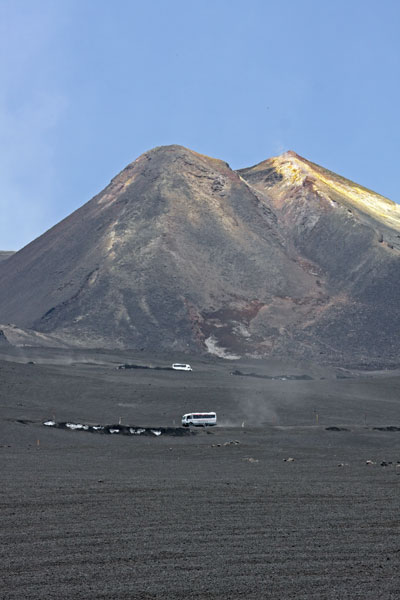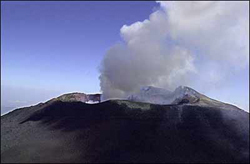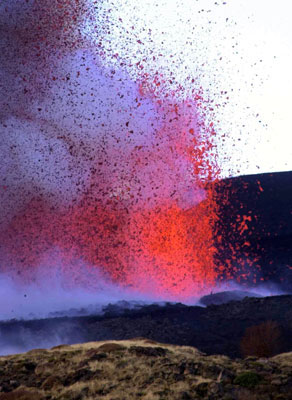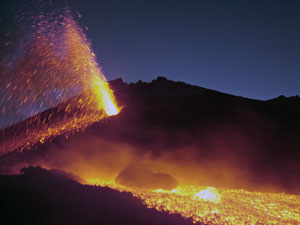Important cities of Sicily: Etna
 It is one of the most active volcanoes in the world and the highest and largest in Europe.
It is one of the most active volcanoes in the world and the highest and largest in Europe.
It is in fact 11.000 ft and covers an area of 606 sq mi.
It is the result of very ancient submarine eruptions in the gulf, which started in the Quaternary period,
about 500.000 years ago,
following movement between the tectonic plates: this released magma up to the ocean floor ìnto the area now occupied by
Acicastello and caused surges of lava and vapour which settled in the vicinity of modern day-Paternò.
The present profile is the result of an explosion circa 14.000 years ago in which the elliptical crater appeared.
Throughout the centuries, because of thousands of explosions, the volcano evoluted into the present form: the summit consists of
four main and active craters, among which the South-East mouth has been the most dangerous one in recent years, while the
sides of Etna, are occupied by more than 250 extinct or secondary craters.
 Etna was considered by the ancient Greeks the forge of the god Vulcan or of the Cyclops; surely Greeks were struck by the violence
of the eruptions and determined that even other giants, like Typhon and Enceladus, lived on and under the mountain.
Etna was considered by the ancient Greeks the forge of the god Vulcan or of the Cyclops; surely Greeks were struck by the violence
of the eruptions and determined that even other giants, like Typhon and Enceladus, lived on and under the mountain.
The name “Etna” was given by the Greeks ( Aetna” ) and it means “to burn”; later on under the Arabs the volcano was called “Gebel ut Lamat”,
the “mountain nearby”. After the Arabs the word used became “Mont Gebel”( Mongibello in Italian), which means “ the Mountain”,
and this latter remained until the beginning of last century. The volcano is known to have erupted regularly during the Antiquity,
at least 135 times. Among early eruptions that of 475 BC has been described by Pindar and Aeschylus, while that of 396, whose
lava reached the sea, is said to have prevented Imilco from marching on Syracuse. In 1169, 1329, and1381, the lava again reached
the sea, twice near Acireale, the third time (1381) at Catania.
 The most famous of most recent eruptions took place in 1669 when a cleft
opened from the crater right down to Nicolosi and out poured a river of lava that spread over a kilometre into the Ionian sea,
devastating everything in its path and killing 20.000 people.
The most famous of most recent eruptions took place in 1669 when a cleft
opened from the crater right down to Nicolosi and out poured a river of lava that spread over a kilometre into the Ionian sea,
devastating everything in its path and killing 20.000 people.
In the 18th and 19th century have been recorded about 30 other eruptions. In May 1923, a terrible fracture out poured lava almost until
the town of Linguaglossa. On November 1928, during the most deadly eruption of the century, two cascades of fire
shot up from a deep cleft in the mountain and destroyed the town of Mascali,and also interrupted the railway from Catania to Messina.
The longest eruption was recorded in 1950-51, when three explosive cones formed in the middle crater.
The highest of these reached 10.912 ft, about the present height of the volcano. The 1971 eruption destroyed the Observatory and
the second stage of the cable-way on the summit as well as vineyards, some houses near Fornazzo, the lava stream cut
several roads and stopped above Sant’ Alfio. More recently the volcano has caused lava streams almost
every year: 1983, 1985, 1990, 1992...
 In 2003 a big secondary mouth opened next to the “Sapienza Refuge” (5500 ft), and lava partially overwhelmed the depart
station of the cable-car, destroyed two small bars and restaurants and threatened some private infrastructures.
In 2003 a big secondary mouth opened next to the “Sapienza Refuge” (5500 ft), and lava partially overwhelmed the depart
station of the cable-car, destroyed two small bars and restaurants and threatened some private infrastructures.
In 1983 Etna has been declared a “Regional Park”, a protected mountain and it has been divided into three different zones:
the lower slopes are under cultivation, those just above are wooded and the uppermost are desert.
Typical crops are: lemons, oranges, cherries, pistachios, and wine grapes.
A volcanic vegetation is also protected: tree spurge, a local variety of milk-vetch, wild violet, and groundsel.
In the woods you can see broom, chestnut, birch, beech, pine and oak trees.
Wild animals also live and are protected in the area: porcupine, fox, wild cat, weasel, marten, dormouse, woodpecker, kestrel,
buzzard and few reptiles like the asp viper.




